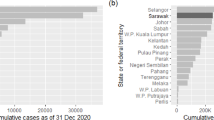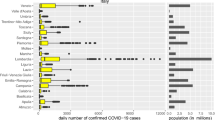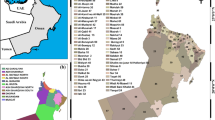Abstract
In 2019, the world grappled with an unexpected and severe global health crisis—the Coronavirus disease (COVID-19) outbreak, which significantly impacted various aspects of human life. This case study, focusing on Bangladesh, aimed to uncover the complex spatial patterns and potential risk factors influencing the virus’s uneven spread across 64 districts. To analyze spatial patterns, two techniques, namely Moran I and Geary C, were employed to study spatial autocorrelation. Hotspots and coldspots were identified using local Moran I, while spatial hotspots were pinpointed using local Getis Ord G. Exploring spatial heterogeneity involved implementing two non-spatial models (Poisson–Gamma and Poisson-Lognormal) and three spatial models (Conditional Autoregressive model, Convolution model, and Leroux model) through Gibbs sampling. The Leroux model emerged as the optimal choice, meeting criteria based on the lowest values of deviance information criterion and Watanabe–Akaike information criterion. Regression analysis revealed that factors such as humidity, population density, and urbanization were associated with an increase in COVID-19 cases, while the aging index appeared to hinder the virus’s spread. The research outcomes provide a comprehensive framework adaptable to the evolving nature of COVID-19 in Bangladesh. It categorizes influential factors into distinct clusters, enabling government agencies, policymakers, and healthcare professionals to make informed decisions for controlling the pandemic and addressing future infectious diseases.







Similar content being viewed by others
Data Availability
The data are available on the website, and the link is provided in Section 2. It will be provided if anyone requires this.
References
Agresti, A. (2003). Categorical data analysis. Wiley.
Aguero-Valverde, J. (2013). Full Bayes Poisson gamma, Poisson lognormal, and zero inflated random effects models: Comparing the precision of crash frequency estimates. Accident Analysis & Prevention, 50, 289–297. https://doi.org/10.1016/j.aap.2012.04.019
Alam, M. R., Karmokar, S., Reza, S., Kabir, M. R., Ghosh, S., & Al Mamun, M. A. (2021). Geriatric malnutrition and depression: Evidence from elderly home care population in Bangladesh. Preventive Medicine Reports, 23, 101478. https://doi.org/10.1016/j.pmedr.2021.101478
Amit, S., Barua, L., & Kafy, A. A. (2021). A perception-based study to explore covid-19 pandemic stress and its factors in Bangladesh. Diabetes & Metabolic Syndrome: Clinical Research & Reviews, 15(4), 102129. https://doi.org/10.1016/j.dsx.2021.05.002
Amit, S., & Kafy, A. A. (2022). A content-based analysis to identify the influence of covid-19 on sharing economy activities. Spatial Information Research, 30(2), 321–333. https://doi.org/10.1007/s41324-022-00433-w
Amit, S., Karim, R., & Kafy, A. A. (2022). Mapping emerging massive open online course (mooc) markets before and after covid 19: A comparative perspective from Bangladesh and India. Spatial Information Research, 30(5), 655–663. https://doi.org/10.1007/s41324-022-00463-4
Anselin, L. (1988). Spatial econometrics: Methods and models (Vol. 4). Springer.
Anselin, L. (1995). Local indicators of spatial association-lisa. Geographical Analysis, 27(2), 93–115. https://doi.org/10.1111/j.1538-4632.1995.tb00338.x
Aswi, A., Cramb, S., Duncan, E., & Mengersen, K. (2020). Evaluating the impact of a small number of areas on spatial estimation. International Journal of Health Geographics, 19(1), 1–14. https://doi.org/10.1186/s12942-020-00233-1
Bayode, T., Popoola, A., Akogun, O., Siegmund, A., Magidimisha-Chipungu, H., & Ipingbemi, O. (2022). Spatial variability of covid-19 and its risk factors in Nigeria: A spatial regression method. Applied Geography, 138, 102621. https://doi.org/10.1016/j.apgeog.2021.102621
Besag, J. (1974). Spatial interaction and the statistical analysis of lattice systems. Journal of the Royal Statistical Society: Series B (Methodological), 36(2), 192–225. https://doi.org/10.1111/j.2517-6161.1974.tb00999.x
Besag, J., & Kooperberg, C. (1995). On conditional and intrinsic autoregressions. Biometrika, 82(4), 733–746. https://doi.org/10.1093/biomet/82.4.733
Besag, J., York, J., & Mollié, A. (1991). Bayesian image restoration, with two applications in spatial statistics. Annals of the Institute of Statistical Mathematics, 43(1), 1–20. https://doi.org/10.1007/BF00116466
Best, N., Richardson, S., & Thomson, A. (2005). A comparison of Bayesian spatial models for disease mapping. Statistical Methods in Medical Research, 14(1), 35–59. https://doi.org/10.1191/0962280205sm388oa
Chan, K. H., Peiris, J. M., Lam, S., Poon, L., Yuen, K., & Seto, W. H. (2011). The effects of temperature and relative humidity on the viability of the sars coronavirus. Advances in Virology. https://doi.org/10.1155/2011/734690
Chou, Y. H. (2005). Spatial pattern and spatial autocorrelation. Spatial information theory a theoretical basis for gis: International conference cosit’95 Semmering, Austria, September 21–23, 1995 proceedings (pp. 365–376).
Clayton, D., & Kaldor, J. (1987). Empirical Bayes estimates of age-standardized relative risks for use in disease mapping. Biometrics. https://doi.org/10.2307/2532003
Cliff, A., & Ord, J. (1973). Spatial autocorrelation. National Library of Australia. https://doi.org/10.1177/030913259501900205
Cramb, S., Duncan, E., Baade, P., & Mengersen, K. (2018). Investigation of Bayesian spatial models.
Cressie, N. (1993). Statistics for spatial data (revised). Wiley. https://doi.org/10.1002/9781119115151
Cressie, N., & Read, T. R. (1989). Spatial data analysis of regional counts. Biometrical Journal, 31(6), 699–719. https://doi.org/10.1002/bimj.4710310607
Das, A., Ghosh, S., Das, K., Basu, T., Dutta, I., & Das, M. (2021). Living environment matters: Unravelling the spatial clustering of covid-19 hotspots in Kolkata megacity, India. Sustainable Cities and Society, 65, 102577. https://doi.org/10.1016/j.scs.2020.102577
Djukpen, R. O. (2012). Mapping the hiv/aids epidemic in Nigeria using exploratory spatial data analysis. GeoJournal, 77(4), 555–569. https://doi.org/10.1007/s10708-010-9350-1
Doll, S. R. (1980). The epidemiology of cancer. Cancer, 45(10), 2475–2485. https://doi.org/10.1002/1097-0142(19800515)45:10<2475::aid-cncr2820451004>3.0.co;2-6
Dutta, I., Basu, T., & Das, A. (2021). Spatial analysis of covid-19 incidence and its determinants using spatial modeling: A study on India. Environmental Challenges, 4, 100096. https://doi.org/10.1016/j.envc.2021.100096
Efron, B., & Morris, C. (1975). Data analysis using stein’s estimator and its generalizations. Journal of the American Statistical Association, 70(350), 311–319. https://doi.org/10.2307/2285814
Elliott, P., & Wartenberg, D. (2004). Spatial epidemiology: Current approaches and future challenges. Environmental Health Perspectives, 112(9), 998–1006. https://doi.org/10.1289/ehp.6735
Fortuna, S., Setiawan, R. P., & Sharifi, A. (2023). Do spatial and sociodemographic factors affect the transmission pattern of covid-19? Evidence from Surabaya city, Indonesia. International Journal of Disaster Risk Reduction, 96, 103900.
Geary, R. C. (1954). The contiguity ratio and statistical mapping. The Incorporated Statistician, 5(3), 115–146. https://doi.org/10.2307/2986645
Gelman, A., Hwang, J., & Vehtari, A. (2014). Understanding predictive information criteria for Bayesian models. Statistics and Computing, 24(6), 997–1016. https://doi.org/10.1007/s11222-013-9416-2
Geman, S., & Geman, D. (1984). Stochastic relaxation, Gibbs distributions, and the Bayesian restoration of images. IEEE Transactions on Pattern Analysis and Machine Intelligence, 6, 721–741. https://doi.org/10.1109/TPAMI.1984.4767596
Getis, A. (2009). Spatial autocorrelation. Handbook of applied spatial analysis: Software tools, methods and applications (pp. 255–278). Springer.
Getis, A., & Griffith, D. A. (2002). Comparative spatial filtering in regression analysis. Geographical Analysis, 34(2), 130–140. https://doi.org/10.1111/j.1538-4632.2002.tb01080.x
Getis, A., & Ord, J. K. (1992). The analysis of spatial association by use of distance statistics. Geographical Analysis, 24(3), 189–206. https://doi.org/10.1111/j.1538-4632.1992.tb00261.x
Guo, Y. R., Cao, Q. D., Hong, Z. S., Tan, Y. Y., Chen, S. D., Jin, H. J., & Yan, Y. (2020). The origin, transmission and clinical therapies on coronavirus disease 2019 (covid-19) outbreak-an update on the status. Military Medical Research, 7, 1–10. https://doi.org/10.1186/s40779-020-00240-0
Haight, F. A. (1967). Handbook of the Poisson distribution. Wiley.
Haining, R. P., & Haining, R. (2003). Spatial data analysis: Theory and practice. Cambridge University Press.
Han, Y., Zhao, W., & Pereira, P. (2022). Global covid-19 pandemic trends and their relationship with meteorological variables, air pollutants and socioeconomic aspects. Environmental Research, 204, 112249. https://doi.org/10.1016/j.envres.2021.112249
Haque, S. E., & Rahman, M. (2020). Association between temperature, humidity, and covid-19 outbreaks in Bangladesh. Environmental Science & Policy, 114, 253–255. https://doi.org/10.1016/j.envsci.2020.08.012
Health, P. (2020). Op-ed: Humidity can aid in the fight against COVID-19. https://www.hsph.harvard.edu/news/hsph-in-the-news/op-ed-humidity-can-aid-in-the-fight-against-covid-19/. Accessed 10-September-2023.
Iddrisu, A. K., & Amoako, Y. A. (2016). Spatial modeling and mapping of tuberculosis using Bayesian hierarchical approaches. Open Journal of Statistics, 6(3), 482–513. https://doi.org/10.4236/ojs.2016.63043
Islam, A., Sayeed, M. A., Rahman, M. K., Ferdous, J., Islam, S., & Hassan, M. M. (2021). Geospatial dynamics of covid-19 clusters and hotspots in Bangladesh. Transboundary and Emerging Diseases, 68(6), 3643–3657. https://doi.org/10.1111/tbed.13973
Islam, J., Guo, X., Ali, M. A., Islam, M. A., Qi, X., & Zhuang, G. (2021). Spatial pattern of covid-19 in Bangladesh: An ecological study. BMJ Open, 11(12), e047566. https://doi.org/10.1136/bmjopen-2020-047566
Islam, M. M., Sultan, S., & Hossain, M. B. (2021). The impact of covid-19 on health of the older persons in Bangladesh. China Population and Development Studies, 5, 332–344. https://doi.org/10.1007/s42379-021-00095-5
Jacquez, G. M., & Greiling, D. A. (2003). Local clustering in breast, lung and colorectal cancer in long island, New York. International Journal of Health Geographics, 2(1), 1–12. https://doi.org/10.1186/1476-072x-2-3
James, W., & Stein, C. (1992). Estimation with quadratic loss. Breakthroughs in Statistics: Foundations and Basic Theory. https://doi.org/10.1007/978-1-4612-0919-5_30
Jeffers, J. (1973). A basic subroutine for Geary’s contiguity ratio. Journal of the Royal Statistical Society. Series D (The Statistician), 22(4), 299–302. https://doi.org/10.2307/2986827
Karim, M., Akter, M., Haque, S., Akter, N., et al. (2021). Do temperature and humidity affect the transmission of sars-cov-2? A flexible regression analysis. Annals of Data Science. https://doi.org/10.1007/s40745-021-00351-y
Karim, M. R. (2023). Bayesian hierarchical spatial modeling of covid-19 cases in Bangladesh. Annals of Data Science. https://doi.org/10.1007/s40745-022-00461-1
Kelejian, H. H., & Prucha, I. R. (2010). Specification and estimation of spatial autoregressive models with autoregressive and heteroskedastic disturbances. Journal of Econometrics, 157(1), 53–67. https://doi.org/10.1016/j.jeconom.2009.10.025
Kelejian, H. H., & Robinson, D. P. (1995). Spatial correlation: A suggested alternative to the autoregressive model. New directions in spatial econometrics (pp. 75–95). Springer.
Kim, H., Sun, D., & Tsutakawa, R. K. (2002). Lognormal vs. gamma: Extra variations. Biometrical Journal: Journal of Mathematical Methods in Biosciences, 44(3), 305–323. https://doi.org/10.1002/1521-4036(200204)44:3<305::AID-BIMJ305>3.0.CO;2-J
Kyung, M., & Ghosh, S. K. (2009). Bayesian inference for directional conditionally autoregressive models. Bayesian Analysis, 4(4), 675–706. https://doi.org/10.1214/09-BA425
Lai, C. C., Shih, T. P., Ko, W. C., Tang, H. J., & Hsueh, P. R. (2020). Severe acute respiratory syndrome coronavirus 2 (sars-cov-2) and coronavirus disease-2019 (covid-19): The epidemic and the challenges. International Journal of Antimicrobial Agents, 55(3), 105924. https://doi.org/10.1016/j.ijantimicag.2020.105924
Lawson, A. B. (2021). Using R for Bayesian spatial and spatio-temporal health modeling. CRC Press.
Lawson, A. B., Browne, W. J., & Rodeiro, C. L. V. (2003). Disease mapping with winbugs and mlwin (Vol. 11). Wiley.
Lee, D. (2013). Carbayes: An r package for Bayesian spatial modeling with conditional autoregressive priors. Journal of Statistical Software, 55(13), 1–24. https://doi.org/10.18637/jss.v055.i13
Lesaffre, E., & Lawson, A. B. (2012). Bayesian biostatistics. Wiley.
Liu, J., & Tian, B. (2023). Spatial statistical analysis and risk factor identification of covid-19 in China. American Journal of Health Behavior, 47(4), 681–705. https://doi.org/10.5993/AJHB.47.4.5
Ma, J., Zhu, H., Li, P., Liu, C., Li, F., Luo, Z., & Li, L. (2022). Spatial patterns of the spread of covid-19 in Singapore and the influencing factors. ISPRS International Journal of Geo-Information, 11(3), 152. https://doi.org/10.3390/ijgi11030152
Magadi, M. A. (2017). Understanding the urban–rural disparity in hiv and poverty nexus: The case of Kenya. Journal of Public Health, 39(3), e63–e72. https://doi.org/10.1093/pubmed/fdw065
Maiti, T. (1998). Hierarchical Bayes estimation of mortality rates for disease mapping. Journal of Statistical Planning and Inference, 69(2), 339–348. https://doi.org/10.1016/s0378-3758(97)00165-1
Marcum, C. S. (2013). Age differences in daily social activities. Research on Aging, 35(5), 612–640. https://doi.org/10.1177/0164027512453468
Mariella, L., & Tarantino, M. (2010). Spatial temporal conditional auto-regressive model: A new autoregressive matrix. Austrian Journal of Statistics, 39(3), 223–244. https://doi.org/10.17713/ajs.v39i3.246
Marshall, R. J. (1991). Mapping disease and mortality rates using empirical Bayes estimators. Journal of the Royal Statistical Society Series C: Applied Statistics, 40(2), 283–294. https://doi.org/10.2307/2347593
Mecenas, P., Bastos, R. T. R. M., Vallinoto, A. C. R., & Normando, D. (2020). Effects of temperature and humidity on the spread of covid-19: A systematic review. PLoS ONE, 15(9), e0238339. https://doi.org/10.1371/journal.pone.0238339
Mollenkopf, H., Hieber, A., & Wahl, H. W. (2017). Continuity and change in older adults’ out-of-home mobility over ten years: A qualitative-quantitative approach. Knowledge and Action. https://doi.org/10.1007/978-3-319-44588-5_15
Moran, P. A. (1950). Notes on continuous stochastic phenomena. Biometrika, 37(1/2), 17–23. https://doi.org/10.2307/2332142
Morris, C. N. (1983). Natural exponential families with quadratic variance functions: Statistical theory. The Annals of Statistics. https://doi.org/10.1214/aos/1176346158
NAC, C. (1993). Statistics for spatial data. Probab Math Statist. https://doi.org/10.1002/9781119115151
Neyens, T., Faes, C., & Molenberghs, G. (2012). A generalized Poisson-gamma model for spatially overdispersed data. Spatial and Spatio-temporal Epidemiology, 3(3), 185–194. https://doi.org/10.1016/j.sste.2011.10.004
Ntzoufras, I., Katsis, A., & Karlis, D. (2005). Bayesian assessment of the distribution of insurance claim counts using reversible jump mcmc. North American Actuarial Journal, 9(3), 90–108. https://doi.org/10.1080/10920277.2005.10596213
Paules, C. I., Marston, H. D., & Fauci, A. S. (2020). Coronavirus infections-more than just the common cold. Jama, 323(8), 707–708. https://doi.org/10.1001/jama.2020.0757
Peng, X., & Wang, T. (2017). Does social medical insurance alleviate the health inequality of minors. China Indus Econ, 12, 59–77.
Rahman, S., Amit, S., & Kafy, A. A. (2022). Impact of covid-19 and telehealth on mental health in Bangladesh: A propensity score matching approach. Spatial Information Research, 30(3), 347–354. https://doi.org/10.1007/s41324-022-00434-9
Ramírez-Aldana, R., Gomez-Verjan, J. C., & Bello-Chavolla, O. Y. (2020). Spatial analysis of covid-19 spread in Iran: Insights into geographical and structural transmission determinants at a province level. PLoS Neglected Tropical Diseases, 14(11), e0008875. https://doi.org/10.1371/journal.pntd.0008875
Rogerson, P. A. (2001). Data reduction: Factor analysis and cluster analysis. Statistical Methods for Geography, 2001, 192–97. https://doi.org/10.4135/9781849209953
Rosenberg, M. S., Sokal, R. R., Oden, N. L., & DiGiovanni, D. (1999). Spatial autocorrelation of cancer in western Europe. European Journal of Epidemiology, 15(1), 15–22. https://doi.org/10.1023/A:1007559728848
Saha, P., & Gulshan, J. (2021). Systematic assessment of covid-19 pandemic in Bangladesh: Effectiveness of preparedness in the first wave. Frontiers in Public Health, 9, 628931. https://doi.org/10.3389/fpubh.2021.628931
Sarkar, S. K., Ekram, K. M. M., & Das, P. C. (2021). Spatial modeling of covid-19 transmission in Bangladesh. Spatial Information Research, 29(5), 715–726. https://doi.org/10.1007/s41324-021-00387-5
Schläpfer, M., Bettencourt, L. M., Grauwin, S., Raschke, M., Claxton, R., Smoreda, Z., & Ratti, C. (2014). The scaling of human interactions with city size. Journal of the Royal Society Interface, 11(98), 20130789. https://doi.org/10.1098/rsif.2013.0789
Senan, A., Tarek, M. O. R., Amit, S., Rahman, I., & Kafy, A. A. (2022). Re-opening the Bangladesh economy: Search for a framework using a risk importance space. Spatial Information Research, 30(4), 539–549. https://doi.org/10.1007/s41324-022-00450-9
Shi, Y., Deng, M., Yang, X., & Liu, Q. (2017). A spatial anomaly points and regions detection method using multi-constrained graphs and local density. Transactions in GIS, 21(2), 376–405. https://doi.org/10.1111/tgis.12208
Smans, M., Muir, C. S., & Boyle, P. (1992). Atlas of cancer mortality in the European economic community. IARC Scientific Publications.
Sohrabi, C., Alsafi, Z., Oneill, N., Khan, M., Kerwan, A. C., & Agha, R. (2020). World health organization declares global emergency: A review of the 2019 novel coronavirus (covid-19). International Journal of Surgery, 76, 71–76. https://doi.org/10.1016/j.ijsu.2020.02.034
Sun, P., Lu, X., Xu, C., Sun, W., & Pan, B. (2020). Understanding of covid-19 based on current evidence. Journal of Medical Virology, 92(6), 548–551. https://doi.org/10.1002/jmv.25722
Tan, J., Mu, L., Huang, J., Yu, S., Chen, B., & Yin, J. (2005). An initial investigation of the association between the sars outbreak and weather: With the view of the environmental temperature and its variation. Journal of Epidemiology and Community Health, 59(3), 186. https://doi.org/10.1136/jech.2004.020180
Tiefelsdorf, M., & Boots, B. (1997). A note on the extremities of local Moran’s Iis and their impact on global Moran’s I. Geographical Analysis, 29(3), 248–257. https://doi.org/10.1111/j.1538-4632.1997.tb00960.x
Tsai, P. J., Lin, M. L., Chu, C. M., & Perng, C. H. (2009). Spatial autocorrelation analysis of health care hotspots in Taiwan in 2006. BMC Public Health, 9(1), 1–13. https://doi.org/10.1186/1471-2458-9-464
Venkatesan, P., Srinivasan, R., & Dharuman, C. (2012). Bayesian conditional auto regressive model for mapping tuberculosis prevalence in India. IJPSR, 3(1), 1–3.
Vlahov, D., Freudenberg, N., Proietti, F., Ompad, D., Quinn, A., Nandi, V., & Galea, S. (2007). Urban as a determinant of health. Journal of Urban Health, 84, 16–26. https://doi.org/10.1007/s11524-007-9169-3
Wang, J., Tang, K., Feng, K., Lv, W., et al. (2020). High temperature and high humidity reduce the transmission of covid-19. Available at SSRN, 3551767, 2020b.
Worldometer. (2022). Bangladesh COVID-Coronavirus Statistics-Worldometer. https://www.worldometers.info/coronavirus/country/bangladesh/. Accessed 10-September-2023
Wu, T., Perrings, C., Kinzig, A., Collins, J. P., Minteer, B. A., & Daszak, P. (2017). Economic growth, urbanization, globalization, and the risks of emerging infectious diseases in China: A review. Ambio, 46, 18–29. https://doi.org/10.1007/s13280-016-0809-2
Yu, D., Li, X., Yu, J., Shi, X., Liu, P., & Tian, P. (2021). Whether urbanization has intensified the spread of infectious diseases-renewed question by the covid-19 pandemic. Frontiers in Public Health, 9, 699710. https://doi.org/10.3389/fpubh.2021.699710
Yuan, J., Yun, H., Lan, W., Wang, W., Sullivan, S. G., Jia, S., & Bittles, A. H. (2006). A climatologic investigation of the sars-cov outbreak in Beijing, China. American Journal of Infection Control, 34(4), 234–236. https://doi.org/10.1016/j.ajic.2005.12.006
Funding
This research received no specific grant from any funding agency in the public, commercial, or not-for-profit sectors.
Author information
Authors and Affiliations
Contributions
The second author designed and supervised the research. The first author collected data and carried out the implementation. She performed the data analysis and wrote a draft copy of the manuscript. The second author checked the data analysis and results and then finalized the manuscript. All authors reviewed the whole manuscript.
Corresponding author
Ethics declarations
Conflict of interest
The authors declare that they have no conflict of interest.
Ethics approval
We have conducted ourselves with integrity, fidelity, and honesty. We have not intentionally engaged in or participated in any form of malicious harm to another person or animal.
Consent to participate:
Not Applicable.
Consent for publication:
Not Applicable.
Code Availability
The R code is available. It will be provided if anyone requires this.
Rights and permissions
Springer Nature or its licensor (e.g. a society or other partner) holds exclusive rights to this article under a publishing agreement with the author(s) or other rightsholder(s); author self-archiving of the accepted manuscript version of this article is solely governed by the terms of such publishing agreement and applicable law.
About this article
Cite this article
Barket, SE., Karim, M.R. Spatial analysis of COVID-19 risk factors: a case study in Bangladesh. Aerobiologia (2024). https://doi.org/10.1007/s10453-024-09815-z
Received:
Accepted:
Published:
DOI: https://doi.org/10.1007/s10453-024-09815-z




